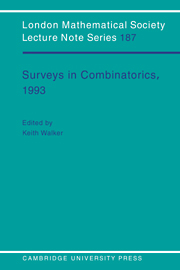Book contents
- Frontmatter
- Contents
- Preface
- Restricted colorings of graphs
- Polynomials in finite geometries and combinatorics
- Models of random partial orders
- Applications of submodular functions
- Weighted quasigroups
- Graphs with projective subconstituents which contain short cycles
- On circuit covers, circuit decompositions and Euler tours of graphs
- Slicing the hypercube
- Combinatorial designs and cryptography
Restricted colorings of graphs
Published online by Cambridge University Press: 16 March 2010
- Frontmatter
- Contents
- Preface
- Restricted colorings of graphs
- Polynomials in finite geometries and combinatorics
- Models of random partial orders
- Applications of submodular functions
- Weighted quasigroups
- Graphs with projective subconstituents which contain short cycles
- On circuit covers, circuit decompositions and Euler tours of graphs
- Slicing the hypercube
- Combinatorial designs and cryptography
Summary
Abstract
The problem of properly coloring the vertices (or edges) of a graph using for each vertex (or edge) a color from a prescribed list of permissible colors, received a considerable amount of attention. Here we describe the techniques applied in the study of this subject, which combine combinatorial, algebraic and probabilistic methods, and discuss several intriguing conjectures and open problems. This is mainly a survey of recent and less recent results in the area, but it contains several new results as well.
Introduction
Graph coloring is arguably the most popular subject in graph theory. An interesting variant of the classical problem of coloring properly the vertices of a graph with the minimum possible number of colors arises when one imposes some restrictions on the colors available for every vertex. This variant received a considerable amount of attention that led to several fascinating conjectures and results, and its study combines interesting combinatorial techniques with powerful algebraic and probabilistic ideas. The subject, initiated independently by Vizing [51] and by Erdös, Rubin and Taylor [24], is usually known as the study of the choosability properties of a graph. In the present paper we survey some of the known recent and less recent results in this topic, focusing on the techniques involved and mentioning some of the related intriguing open problems. This is mostly a survey article, but it contains various new results as well.
- Type
- Chapter
- Information
- Surveys in Combinatorics, 1993 , pp. 1 - 34Publisher: Cambridge University PressPrint publication year: 1993
- 36
- Cited by



